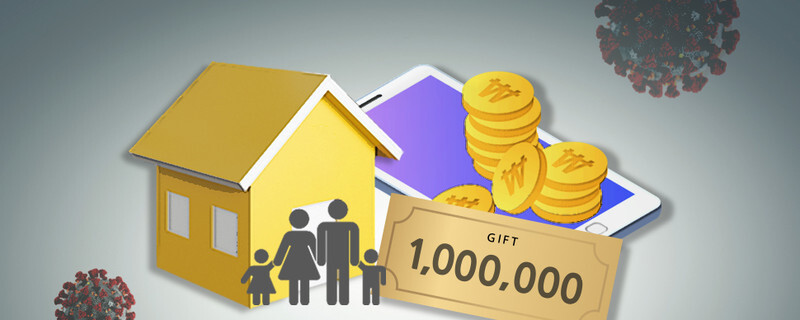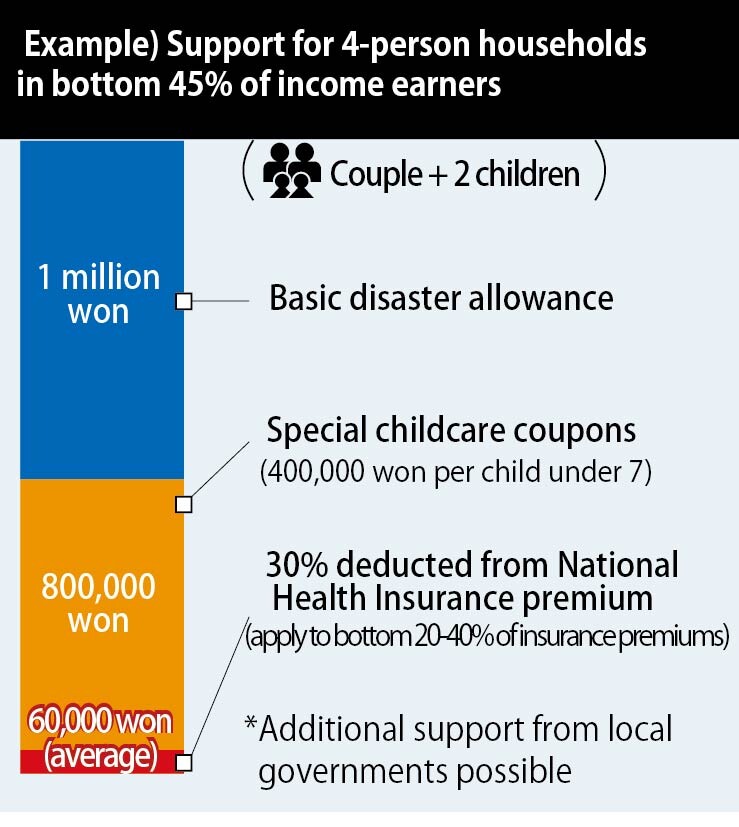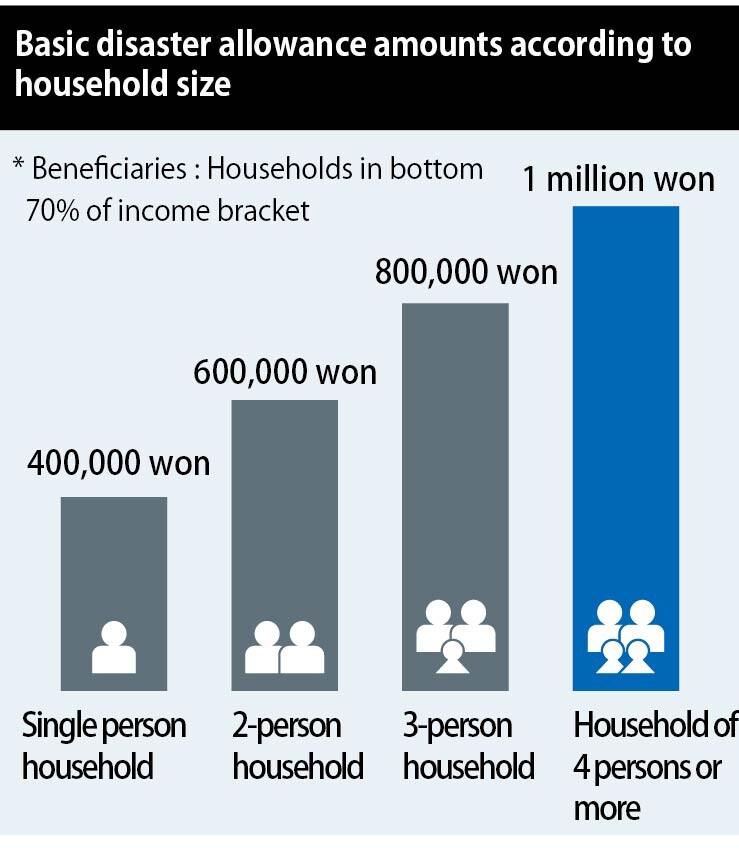hankyoreh
Links to other country sites 다른 나라 사이트 링크
Basic disaster allowances can overlap with other benefits and payments from local governments

The plan finalized by the South Korean government at a meeting of its emergency economic council on Mar. 30 for the adoption of basic disaster allowances in response to the novel coronavirus outbreak means that 14 million households across South Korea will receive 400,000 to 1,000,000 million won (US$328-820) in vouchers and/or electronic currency. Some beneficiaries will also receive overlapping support with vouchers that are to be paid to low-income individuals and children from the first supplementary budget. Additionally, premiums for health insurance and the three other major types of insurance are to be reduced and/or deferred for a period of three months. A low-income family of four (including two children) classified as below the near-poverty line could receive living benefits between 2.9 million (US$2,378) and 3.2 million won (US$2,624) in total.

The beneficiaries of the basic disaster allowances represent all but the top-earning 30% among all households, or around 14 million households in all. While the government had initially advocated payments to 10 million households, the targets were broadened in subsequent discussions between the Democratic Party and the Blue House.
“We based our decision on [support for] the lowest-earning 70% on the fact that the damage caused by the coronavirus is not limited to any particular segment, and that it’s a shared difficulty faced by a majority of South Koreans,” Deputy Prime Minister and Minister of Economy and Finance Hong Nam-ki said in a briefing that day following the emergency economic meeting. Hong also asked for “generous understanding over our inability to include the top-earning 30% among the recipients due to various circumstances.”
The government said it would issue a separate announcement after determining the exact income standard regarding the lowest-earning 70%. According to a 2018 household financial welfare survey, 29.1% of all households exceeded the standard of 150% of the median income (representing the centermost value when all incomes are ranked). Accordingly, the standard for determining the lowest-earning 70% appears likely to fall along the same lines as the standard of 150% of the median income, which amounts to monthly earnings of 2.64 million won (US$2,164) for a single-person household, 4.49 million won (US$3,681) for a two-person household, 5.81 million won (US$4,763) for a three-person household, and 7.12 million won (US$5,387) for a four-person household.

The amounts of basic disaster allowances are to be differentiated by number of household members: 400,000 won (US$328) in benefits for a single-person household, 600,000 won (US$492) for two people, 800,000 won (US$656) for three, and 1 million won (US$820) for four or more. To ensure that support actually leads to consumption, it is to be provided in the form of local vouchers and electronic currency rather than cash.
Basic disaster allowances will also be made available to around 1,687,000 households including basic livelihood security beneficiaries or those legally recognized as near-poverty that are receiving consumption coupons in accordance with the first supplementary budget passed on Mar. 17. In the case of a four-person household with two children, a recipient of livelihood and/or medical benefits receives in 1.4 million won (US$1,148) in consumption coupons over the four-month period from March to June, while a recipient of residential and/or education benefits and a member of the near-poverty class receives 1.08 million won (US$885) for four months.
Special childcare coupons for those with children under 7In addition to the child allowance of 100,000 won (US$82) already paid for families with children under seven years of age, special childcare coupons worth 400,000 won (US$328) are provided per child for four months, bringing the total benefits to 800,000 won (US$656). With the 1 million (US$885) won in basic disaster allowance and health insurance premium reductions, livelihood/medical beneficiary households will receive a total of 3.2 million won (US$2,624). In the cases of residential/educational beneficiary and near-poverty households, the amount may differ slightly according to the amount of health insurance premium reductions, but households appear likely to receive upwards of 2.9 million won (US$2,378).
A household in the lowest-earning 45% for income will receive upwards of 1.86 million won (US$1,525), including 1 million won in emergency disaster relief support, 800,000 won (US$656) in special caregiving coupons, and an average of 600,000 won (US$492) in health insurance premium reductions (for workplace subscribers with premiums falling in the lowest 20-40%).
The amount could increase even more with separate disaster allowances provided by local governments in addition to central government payments.
“Once the supplementary budget is finalized, there will be cases where local governments are providing disaster allowances that overlap with the money the central government is providing. Support could end up being even larger than [the central government’s allowances] as the local governments contribute more financial resources,” Hong said.
But differences in the amount of support by local governments could trigger a debate over fairness as total support varies according to beneficiaries’ place of residence.
The emergency disaster relief support will cost a total of 9.1 trillion won (US$7.46 billion) to provide. The central government is to provide 7.1 trillion won (US$5.82 billion) through a second supplementary budget, with the remaining 2 trillion won (US$1.64 billion) to be provided by local governments. The central government plans to move quickly in submitting the second supplementary budget plan to the National Assembly, with a target National Assembly passage date in mid-April shortly after the general elections on Apr. 15. If the supplementary budget is passed in April, support funds appear likely to be made available by May.
By Lee Kyung-mi, staff reporter
Please direct comments or questions to [english@hani.co.kr]

Editorial・opinion
![[Column] Season 2 of special prosecutor probe may be coming to Korea soon [Column] Season 2 of special prosecutor probe may be coming to Korea soon](https://flexible.img.hani.co.kr/flexible/normal/500/300/imgdb/original/2024/0426/3317141030699447.jpg) [Column] Season 2 of special prosecutor probe may be coming to Korea soon
[Column] Season 2 of special prosecutor probe may be coming to Korea soon![[Column] Park Geun-hye déjà vu in Yoon Suk-yeol [Column] Park Geun-hye déjà vu in Yoon Suk-yeol](https://flexible.img.hani.co.kr/flexible/normal/500/300/imgdb/original/2024/0424/651713945113788.jpg) [Column] Park Geun-hye déjà vu in Yoon Suk-yeol
[Column] Park Geun-hye déjà vu in Yoon Suk-yeol- [Editorial] New weight of N. Korea’s nuclear threats makes dialogue all the more urgent
- [Guest essay] The real reason Korea’s new right wants to dub Rhee a founding father
- [Column] ‘Choson’: Is it time we start referring to N. Korea in its own terms?
- [Editorial] Japan’s rewriting of history with Korea has gone too far
- [Column] The president’s questionable capacity for dialogue
- [Column] Are chaebol firms just pizza pies for families to divvy up as they please?
- [Column] Has Korea, too, crossed the Rubicon on China?
- [Correspondent’s column] In Japan’s alliance with US, echoes of its past alliances with UK
Most viewed articles
- 1AI is catching up with humans at a ‘shocking’ rate
- 2After election rout, Yoon’s left with 3 choices for dealing with the opposition
- 3Is Japan about to snatch control of Line messenger from Korea’s Naver?
- 4South Korea officially an aged society just 17 years after becoming aging society
- 51 in 5 unwed Korean women want child-free life, study shows
- 6[Column] ‘Choson’: Is it time we start referring to N. Korea in its own terms?
- 7Korea’s 1.3% growth in Q1 signals ‘textbook’ return to growth, says government
- 8No good, very bad game for Korea puts it out of Olympics for first time since 1988
- 9[Editorial] Japan’s rewriting of history with Korea has gone too far
- 10Why Korea shouldn’t welcome Japan’s newly beefed up defense cooperation with US